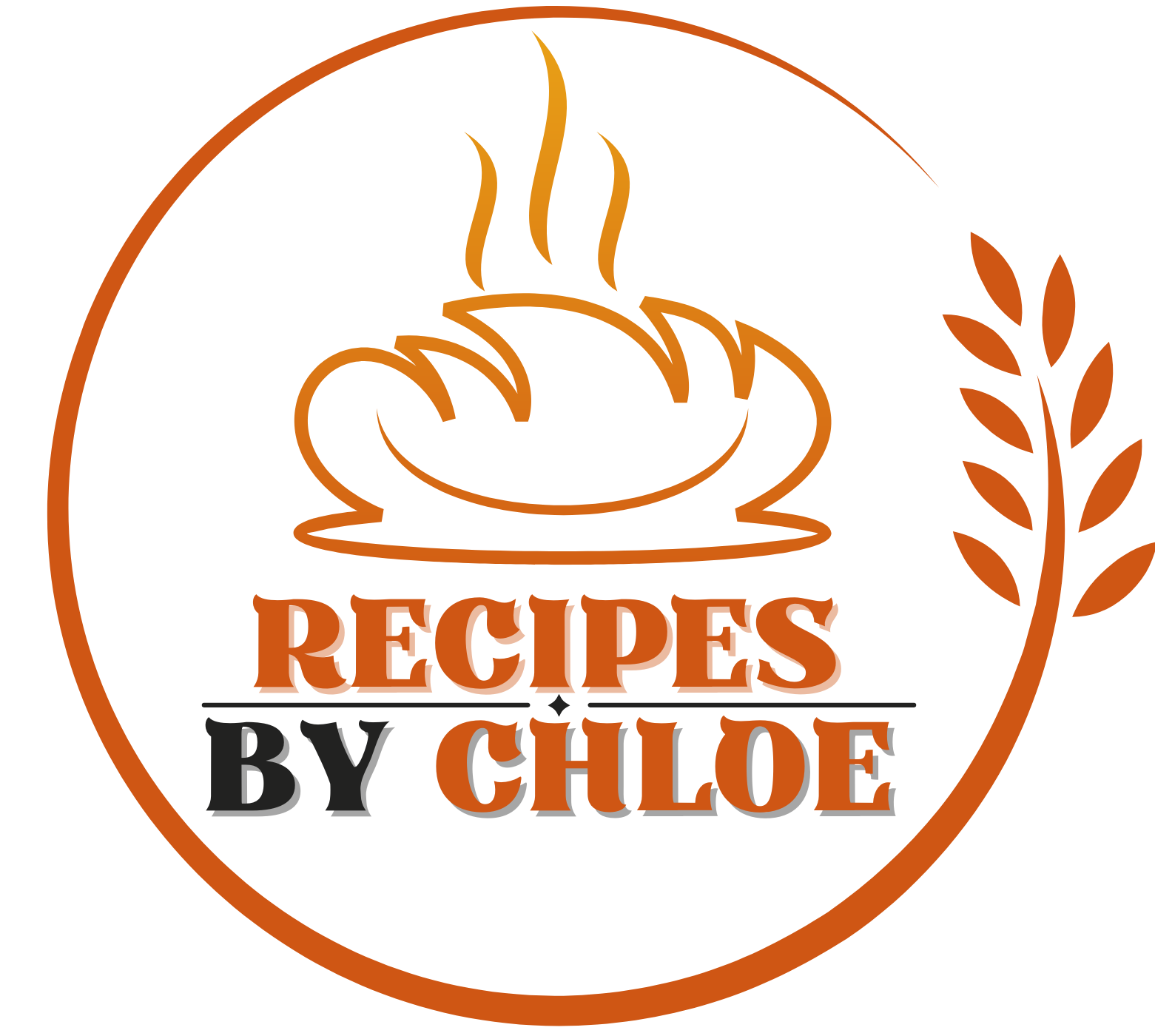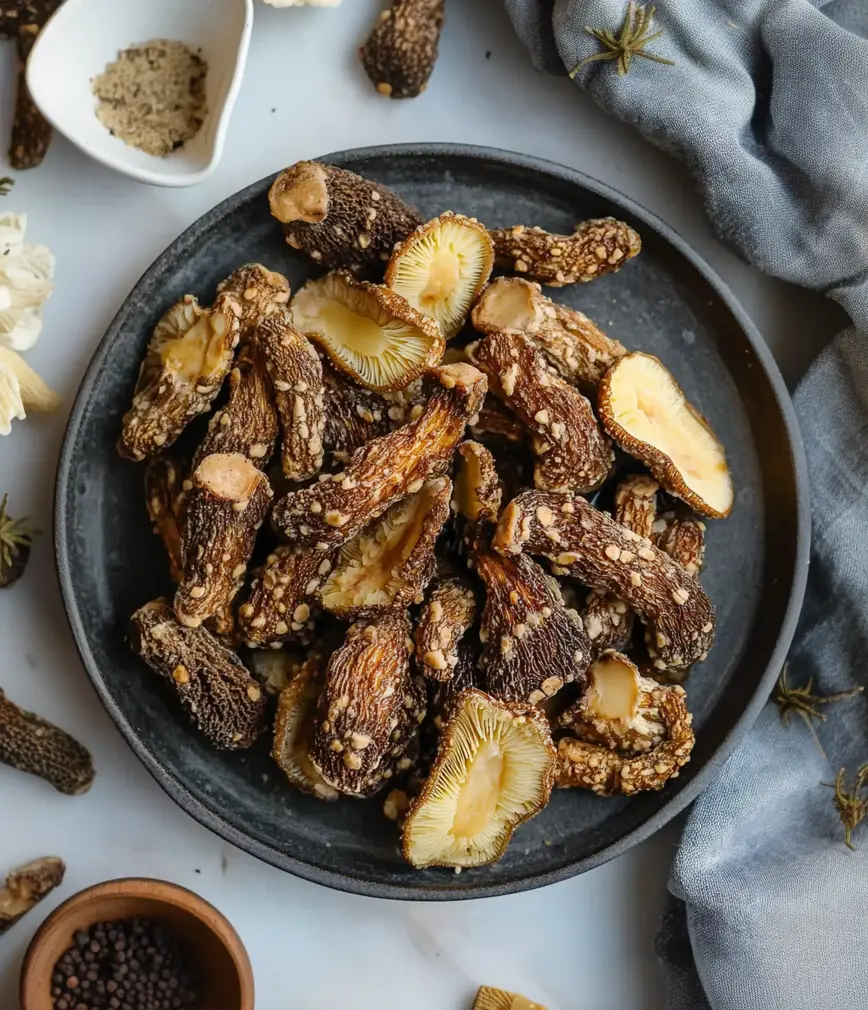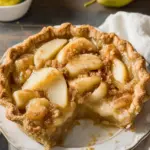Pan-Fried Morel Mushrooms are a seasonal delicacy that celebrates the earthy, nutty flavor of wild-foraged morels. This simple yet indulgent recipe involves cleaning the mushrooms thoroughly, dredging them in seasoned flour, and pan-frying in butter until golden and crispy. The result is a savory, crunchy bite reminiscent of fried chicken skin—perfect as an appetizer, side dish, or gourmet snack.
Full Recipe:
Ingredients
- 1 to 2 pounds fresh morel mushrooms
- 1½ cups unbleached all-purpose flour
- 1 rounded teaspoon fine sea salt
- 1 teaspoon garlic powder
- 1 teaspoon onion powder
- ½ teaspoon freshly ground black pepper
- 1 stick (½ cup) good-quality butter
- Paprika, for garnish (optional)
Directions
- Clean the Morels: Place the morels in a large bowl filled with warm (not hot) water and about 1 tablespoon of salt. Cover with paper towels to keep them submerged and soak in the refrigerator for 2 hours or overnight. This helps remove dirt and insects. After soaking, transfer the morels to a paper towel-lined bowl to absorb excess water. Repeat the soaking process with fresh saltwater, this time cutting the morels in half lengthwise, and soak for an additional 1 to 2 hours.
- Prepare the Dredge: In a large resealable gallon-size bag, combine the flour, sea salt, garlic powder, onion powder, and black pepper. Seal and shake to mix thoroughly.
- Dredge the Morels: Place 5 or 6 morels into the flour mixture. Seal the bag and gently shake until the mushrooms are well-coated. Shake off any excess flour and place the coated morels onto a rimmed sheet pan. Repeat with the remaining mushrooms.
- Pan-Fry: Melt the butter in a deep-sided stainless steel frying pan over medium heat. Once the butter is hot, add a few morels to the skillet, cut side down, without overcrowding. Cook for 6 to 7 minutes, or until golden brown. Carefully turn the morels and cook for an additional 5 to 6 minutes. Note that subsequent batches may cook faster, so monitor closely.
- Serve: Transfer the fried morels to a paper towel-lined plate to drain excess butter. Sprinkle with a little paprika, if desired, and serve immediately. These mushrooms pair wonderfully with a cold beer or a glass of white wine.
Nutrients
While specific nutritional information for this exact recipe isn’t provided, a similar pan-fried morel mushroom recipe yields approximately the following per serving (based on 4 servings):
- Calories: 293
- Total Fat: 17g
- Saturated Fat: 9g
- Trans Fat: 1g
- Unsaturated Fat: 7g
- Cholesterol: 124mg
- Sodium: 686mg
- Carbohydrates: 27g
- Fiber: 4g
- Sugar: 1g
- Protein: 10g
Why Pan-Fried Morel Mushrooms?
Pan-frying is a simple but incredibly effective cooking method that highlights the natural flavors and textures of morel mushrooms. When sautéed in butter, morels develop a golden, crispy crust that adds a delightful contrast to their tender interior. This method preserves the delicate mushroom flavor without overpowering it with heavy sauces or complex preparations.
This recipe is especially popular because it is accessible to home cooks. It doesn’t require complicated techniques or hard-to-find ingredients. The process of soaking the mushrooms to clean them ensures all dirt and tiny insects are removed, which is crucial since morels grow in the wild. The seasoned flour coating adds flavor and texture, creating a crust that locks in the juiciness of the mushrooms while offering a satisfying crunch.
The Culinary Versatility of Morels
Morel mushrooms are incredibly versatile. While pan-frying them in butter is a favorite way to enjoy their pure flavor, morels can also be incorporated into a wide range of dishes. They pair beautifully with creamy sauces, pasta, risottos, and even eggs. Their meaty texture makes them a great vegetarian alternative to meat in many recipes.
Chefs often use morels in fine dining to elevate the simplest dishes. Their unique flavor complements rich ingredients like cream, butter, and cheese, but they also balance well with fresh herbs, garlic, and shallots. The earthy undertones of morels lend depth and complexity to any dish.
Nutritional Benefits of Morel Mushrooms
Morel mushrooms aren’t just delicious—they also pack a nutritious punch. They are low in calories and fat but rich in important nutrients. Morels are an excellent source of dietary fiber, which supports digestive health. They also contain significant amounts of vitamin D, which is vital for bone health and immune function.
In addition to vitamins, morels offer minerals like iron, manganese, and phosphorus. Iron is essential for oxygen transport in the blood, while manganese plays a role in metabolism and antioxidant defenses. Phosphorus is necessary for healthy bones and teeth. Morels also provide a modest amount of protein, making them a good addition to vegetarian and vegan diets.
The antioxidants found in morels help protect cells from oxidative damage, which is linked to chronic diseases and aging. Their unique compounds have been studied for potential anti-inflammatory and immune-boosting properties.
Foraging and Selecting Morels
Because morels are wild mushrooms, sourcing them requires careful selection. If foraging yourself, it is crucial to be knowledgeable about mushroom identification, as some false morels look similar but are toxic. False morels may contain harmful compounds that can cause severe illness.
For those who do not forage, morels can be found fresh or dried in specialty food stores or markets during the mushroom season. Dried morels are widely available year-round and have a concentrated flavor when rehydrated. Fresh morels have a delicate texture and should be used promptly for best taste.
When selecting morels, look for mushrooms that are firm, free of blemishes, and have an intact honeycomb cap. Avoid any that appear slimy or overly soft. Proper cleaning is essential due to their natural habitat; soaking and rinsing thoroughly is the best way to prepare them for cooking.
Tips for Cooking with Morels
Cooking with morel mushrooms requires some care to get the best results. Because they contain natural moisture, it is important to avoid overcrowding the pan when pan-frying. Overcrowding can cause the mushrooms to steam instead of crisp up. Cooking in batches helps achieve that perfect golden-brown crust.
Butter is the preferred fat for cooking morels, as its rich flavor enhances the mushrooms’ natural earthiness. Adding complementary seasonings such as garlic powder, onion powder, and freshly ground black pepper provides a subtle flavor boost without overwhelming the mushrooms.
Morels are best served immediately after cooking, as their texture and flavor are at their peak when hot and fresh. Serving them with a simple garnish like paprika or fresh herbs can add color and an extra layer of taste.
Pairing Morels with Other Foods
Pan-fried morels work wonderfully as a standalone appetizer, but they also pair beautifully with a variety of dishes. Their rich umami flavor complements proteins like chicken, beef, or fish, and they can be a luxurious addition to salads or grain bowls.
Morels also shine when paired with wines. A crisp white wine, such as Chardonnay or Sauvignon Blanc, enhances the mushroom’s buttery notes. For those who prefer beer, a light ale or pilsner is a refreshing match.
In addition, these mushrooms can be incorporated into brunch dishes—scrambled eggs or omelets studded with sautéed morels elevate a simple breakfast into a gourmet experience. Their meaty texture makes them satisfying and filling.
Cultural and Historical Significance
Morel mushrooms have long been part of traditional cuisines in various cultures, especially in North America and Europe. Indigenous peoples have foraged and consumed morels for generations, appreciating both their flavor and medicinal properties. In French cuisine, morels are celebrated as a premium ingredient and often appear in classic dishes. They are considered a symbol of spring and renewal due to their seasonal availability. Historically, morels were reserved for royalty and the elite due to their scarcity.
Sustainability and Ethical Foraging
As interest in wild foods grows, it is important to consider the sustainability of harvesting morels. Responsible foraging means taking only what you need and leaving enough mushrooms to reproduce. This helps preserve local ecosystems and ensures that morels remain available for future generations. Cultivation of morels has been challenging due to their complex growing requirements, so wild harvesting remains the main source. Supporting local foragers or sustainable suppliers helps maintain ethical practices in the mushroom market.
Conclusion
Pan-Fried Morel Mushrooms are more than just a delicious dish—they represent a connection to nature, tradition, and the art of simple yet elegant cooking. Their unique flavor and texture make them a standout ingredient for both casual cooks and gourmet chefs. Whether you forage them yourself or purchase them fresh or dried, morels offer an opportunity to elevate your meals with a taste of the wild.






